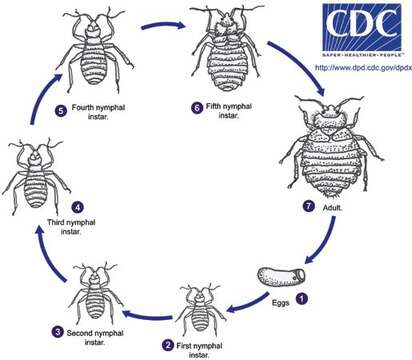Life cycle of Cimex bedbugs

Description:
Life cycle of Cimex bedbugs
Adults and all nymphal stages of Cimex species need to take blood meals from warm-blooded hosts, which are typically humans for C. lectularius and C. hemipterus, although other mammals and birds can be utilized in the absence of a human host. Female bed bugs lay about five eggs (1) daily throughout their adult lives in a sheltered location (mattress seams, crevices in box springs, spaces under baseboards, etc). Eggs hatch in about 4-12 days into first instar nymphs (2) which must take a blood meal before molting to the next stage. The bugs will undergo five nymphal stages (2,3,4,5,6), each one requiring a blood meal before molting to the next stage, with the fifth stage molting into an adult (7). Nymphs, although lacking wing buds, resemble smaller versions of the adults. Nymphs and adults take about 5-10 minutes to obtain a full blood meal. The adults may take several blood meals over several weeks, assuming a warm-blooded host is available. Mating occurs off the host and involves a unique form of copulation called ‘traumatic insemination’ whereby the male penetrates the female’s abdominal wall with his external genitalia and inseminates into her body cavity. Adults live 6-12 months and may survive for long periods of time without feeding.
From Centers for Disease Control Parasites and Health website
Included On The Following Pages:
- Life (creatures)
- Cellular (cellular organisms)
- Eukaryota (eukaryotes)
- Opisthokonta (opisthokonts)
- Metazoa (Animal)
- Bilateria
- Protostomia (protostomes)
- Ecdysozoa (ecdysozoans)
- Arthropoda (arthropods)
- Pancrustacea
- Hexapoda (hexapods)
- Insecta (insects)
- Pterygota (winged insects)
- Neoptera (neopteran)
- Paraneoptera
- Hemiptera (hemipterans)
- Heteroptera (true bugs)
- Cimicomorpha
- Cimicoidea
- Cimicidae (bed bugs)
- Cimex
- Panarthropoda
- Cimex lectularius (bed bug)
This image is not featured in any collections.
Source Information
- license
- cc-by-nc
- copyright
- Centers for Disease Control/Division of Parasitic Diseases and Malaria
- publisher
- Shapiro, Leo
- photographer
- Centers for Disease Control/Division of Parasitic Diseases and Malaria
- provider
- EOL Rapid Response Team
- original
- original media file
- visit source
- partner site
- EOL staff
- ID


